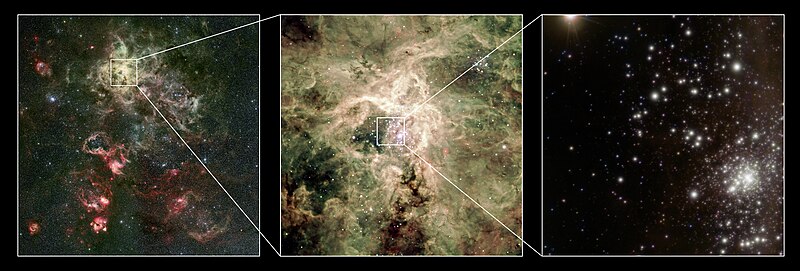File:ESO - Eso1030a (by).jpg

Původní soubor (6 497 × 2 200 pixelů, velikost souboru: 19,49 MB, MIME typ: image/jpeg)
Popisky
Popisky
| PopisESO - Eso1030a (by).jpg |
English: Using a combination of instruments on ESO’s Very Large Telescope, astronomers have discovered the most massive stars to date, some weighing at birth more than 300 times the mass of the Sun, or twice as much as the currently accepted limit of 150 solar masses. The most extreme of these stars was found in the cluster RMC 136a (or R136 as it is more usually named). Named R136a1, it is found to have a current mass of 265 times that of the Sun. Being a little over a million years old, R136a1 is already “middle-aged” and has undergone an intense weight-loss programme, shedding a fifth of its initial mass over that time, or more than fifty solar masses. It also has the highest luminosity, close to 10 million times greater than the Sun.
R136 is a cluster of young, massive and hot stars located inside the Tarantula Nebula, in one of the neighbourhood galaxies of the Milky Way, the Large Magellanic Cloud, 165 000 light-years away. R136 contains so many stars that on a scale equivalent to the distance between the Sun and the nearest star there are tens of thousands of stars. Hundreds of these stars are so incredibly bright that if we were to sit on a (hypothetical) planet in the middle of the cluster the sky would never get dark. This montage shows a visible-light image of the Tarantula nebula as seen with the Wide Field Imager on the MPG/ESO 2.2-metre telescope (left) along with a zoomed-in visible-light image from the Very Large Telescope (middle). A new image of the R136 cluster, obtained with the near-infrared MAD adaptive optics instrument on the Very Large Telescope is shown in the right-hand panel, with the cluster itself at the lower right. The MAD image provides unique details on the stellar content of the cluster. |
||||
| Zdroj | The young cluster RMC 136a | ||||
| Autor | ESO/P. Crowther/C.J. Evans | ||||
| Svolení (Užití tohoto souboru) |
|
||||
Historie souboru
Kliknutím na datum a čas se zobrazí tehdejší verze souboru.
| Datum a čas | Náhled | Rozměry | Uživatel | Komentář | |
|---|---|---|---|---|---|
| současná | 27. 7. 2010, 07:48 | 6 497 × 2 200 (19,49 MB) | ComputerHotline (diskuse | příspěvky) | {{Information |Description={{en|Using a combination of instruments on ESO’s Very Large Telescope, astronomers have discovered the most massive stars to date, some weighing at birth more than 300 times the mass of the Sun, or twice as much as the current |
Tento soubor nemůžete přepsat.
Využití souboru
Na Commons na soubor odkazují tyto stránky:
- File:RMC136 cluster.jpg (přesměrování)
- File:The young cluster RMC 136a.jpg (přesměrování)
Globální využití souboru
Tento soubor využívají následující wiki:
- Využití na af.wikipedia.org
- Využití na ar.wikipedia.org
- Využití na cs.wikipedia.org
- Využití na el.wikipedia.org
- Využití na en.wikipedia.org
- Využití na fa.wikipedia.org
- Využití na fr.wikipedia.org
- Využití na gl.wikipedia.org
- Využití na he.wikipedia.org
- Využití na ja.wikipedia.org
- Využití na ka.wikipedia.org
- Využití na ko.wikipedia.org
- Využití na mk.wikipedia.org
- Využití na pl.wikipedia.org
- Využití na pt.wikipedia.org
- Využití na ru.wikipedia.org
- Využití na simple.wikipedia.org
- Využití na sl.wikipedia.org
- Využití na sv.wikipedia.org
- Využití na uk.wikipedia.org
- Využití na vi.wikipedia.org
- Využití na www.wikidata.org
- Využití na zh.wikipedia.org
Metadata
Tento soubor obsahuje dodatečné informace, poskytnuté zřejmě digitálním fotoaparátem nebo scannerem, kterým byl pořízen. Pokud byl soubor od té doby změněn, některé údaje mohou být neplatné.
| Použitý software | Adobe Photoshop CS3 Windows |
|---|---|
| Datum a čas vytvoření obrázku | 13. 7. 2010, 13:31 |
| Barevný prostor | Nekalibrováno |
